A bustling fish tank is beautiful to behold – but you can’t just throw any old fish in a tank and hope they get along!
Whether you’re dreaming of showcasing a few striking larger fish or a flurry of silvery little beauties, choosing fish that will get along happily without fights or conflicting needs is a key part of setting up a beautiful community fish tank.
Alongside considerations like what tank size, water filtration, and temperature setup will suit the species in your tank, the need to also select community fish that ‘vibe’ with each other can seem like a real headache.
To help you make the very best selection for your aquarium, we’ve assembled this nifty guide to some peaceful community fish who play nicely with others.
Plus, we’ve answered some frequently asked questions about community fish, their care, and how to select fish that fit your needs and tank setup! We hope this guide helps you get your ideal tank set up in no time.
Contents
Honey Gourami

While the standard gourami is blue in shade, Honey Gourami are a warm combination of orange and yellow. They do, however, still have the Gourami’s signature ventral fin.
These fish like plenty of plant life around, and they’re easy to keep, playful in spirit, and fairly docile, so they won’t cause any trouble. However, the males can get a little bit fractious with each other in too small a space, so make sure you increase the tank size for every Honey Gourami you add. They do best at 71-82°F, with a water pH of 6-7.5.
At a Glance:
- Scientific Name: Trichogaster chuna
- Difficulty Level: Easy
- Adult Size: 2 inches
- Minimum Tank Size: 10 gallons
White Cloud Mountain Minnow

This is the perfect community fish to add a little tropical spirit to a cold tank. There are several different varieties, including Golden Cloud and Meteor Minnows, but this wild species is just as gorgeous.
Minnows are a schooling fish, so you’ll need to add plenty to the tank to keep them happy (at least five or six) but the visual impact of them flitting through the top and middle of the tank will be well worth it. Keep them at 57-72°F and pH 6-8.5.
At a Glance:
- Scientific Name: Tanichthys albonubes
- Difficulty Level: Easy
- Adult Size: 1.5 inches
- Minimum Tank Size: 10 gallons
Zebra Danio

Add a lot of flash and activity to all levels of your tank with a school of Zebra Danio, also known as Zebrafish. These freshwater fish like cooler than average temperatures, so they need a tank temperature of 64-75°F, with a pH of 6.5-7.5.
Like minnows, they do best in groups of five or more, and while they’re quite peaceful, fish with long flowy fins might feel a little nip if they get too close. There are a few varieties of Zebra Danio, including glofish, golden, and long-finned Zebra Danio, so there’s plenty of variety to choose from, and you’re sure to love their antics.
At a Glance:
- Scientific Name: Danio rerio
- Difficulty Level: Easy
- Adult Size: 2 to 2.5 inches
- Minimum Tank Size: 10 gallons
Harlequin Rasbora
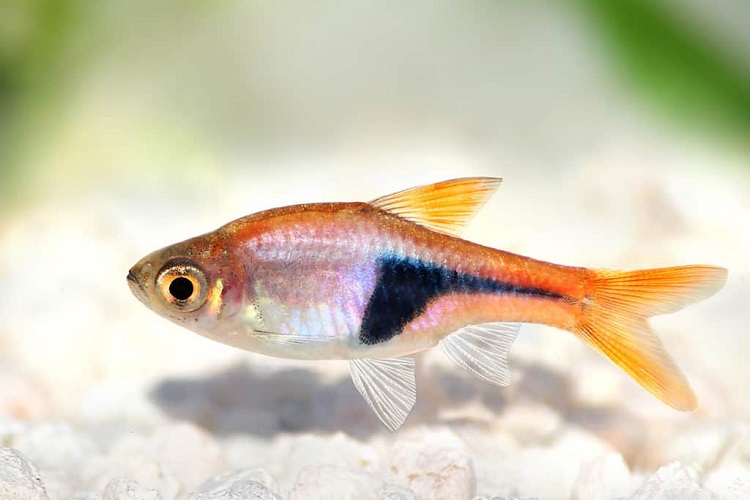
Like most Rasboras, this is a shoaling fish that will need at least a group of 8, and more is definitely better. Harlequin Rasbora are so named because of their eye-catching looks, specifically the triangular-shaped black marking on their sides.
This is a playful species of only moderate activity, making them great to pair with shyer breeds. Keep them at 73-82°F, with a water pH of 6-7.5.
At a Glance:
- Scientific Name: Trigonostigma heteromorpha
- Difficulty Level: Easy
- Size: 2 inches
- Minimum Tank Size: 10 gallons
Diamond Tetra

Reminiscent of a sparkling living diamond, this little community fish is well-named. They’re rarer and a little larger than most other tetras and will need a well-crafted tank, but there’s definitely no denying the visual value their iridescent shine can bring to your aquarium.
They need a small (and odd-numbered) group, so plan for about 5 of them. Give them plenty of places to hide and plants to play around in, and they’ll pay it back in spades. Keep them in temperatures of 80-84°F and a pH of 5.5-6.5.
At a Glance:
- Scientific Name: Moenkhausia pittieri
- Difficulty Level: Easy
- Adult Size: 2 to 2.4 inches
- Minimum Tank Size: 15 gallons
Glowlight Tetra

A smaller fish with an iconic torpedo shape, Glowlight Tetra are native to dark blackwater environments. This Tetra is a near-transparent, silvery fish with a “glowing” yellow-orange stripe. While it’s never good to crowd a tank, they can do well in smaller tank sizes.
Despite their playful nature, they can become quite docile in small numbers and do better in schools of five or more. In sufficient numbers, however, they get along well with other fish species of similar size, though they should be kept away from Angelfish, which are known to attack them. Keep your Glowlight Tetras at a pH of 5.8-7.5, and a water temperature of 74-82°F.
At a Glance:
- Scientific Name: Hemigrammus erythrozonus
- Difficulty Level: Easy
- Adult Size: 1.5 inches
- Minimum Tank Size: 10 gallons
Bristlenose Pleco

As a suckerfish in the catfish family, the Bristlenose Pleco isn’t the prettiest of fish, but this bottom dweller can bring a lot of interest and intrigue to a tank, not to mention free housekeeping.
The Bristlenose Pleco will help you out by sucking up the soft algaes that collect on the bottom of your tank, and they love a driftwood snack to graze on. While they do well with other species, they like to be loners among their own, so don’t expect to have a school of them. They thrive in a pH of 5.5-7.5 and water temperatures of 70-79°F.
At a Glance:
- Scientific Name: Ancistrus spp.
- Difficulty Level: Easy
- Adult Size: 5 inches
- Minimum Tank Size: 30-40 gallons
Dwarf Pencilfish
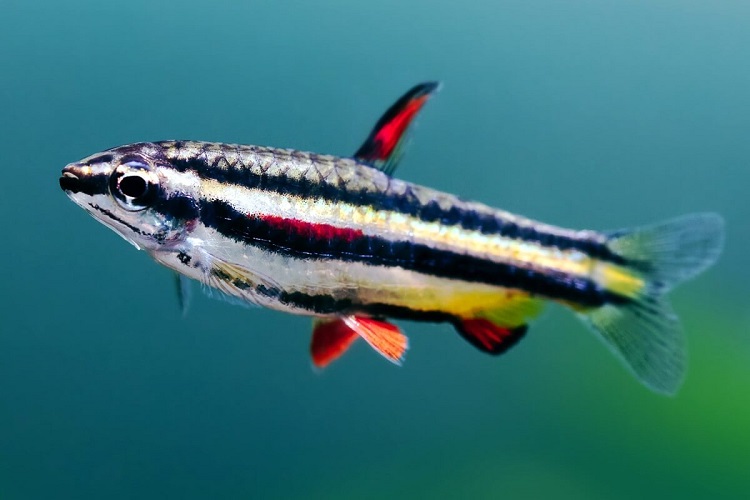
Dwarf Pencilfish are an eye-catching addition to your collection, with transparent fins that have just a dash of color at the base and gorgeous ‘racing stripes’ along their bodies. This unique fish needs low water flow and a well-decorated tank rich in driftwood, plants, and hiding spots.
While they don’t do well with sudden changes, they’re able to adapt to a variety of tank environments and aren’t very difficult to care for. However, they are timid by nature and will hide if placed in a tank with large, aggressive, or boisterous fish. Keep them in a tank at 75-79°F, with a pH of 5.5-7.5.
At a Glance:
- Scientific Name: Nannostomus marginatus
- Difficulty: Easy to Intermediate
- Adult Size: 1.5 inches
- Minimum Tank Size: 4.4 gallons
Dwarf Gourami
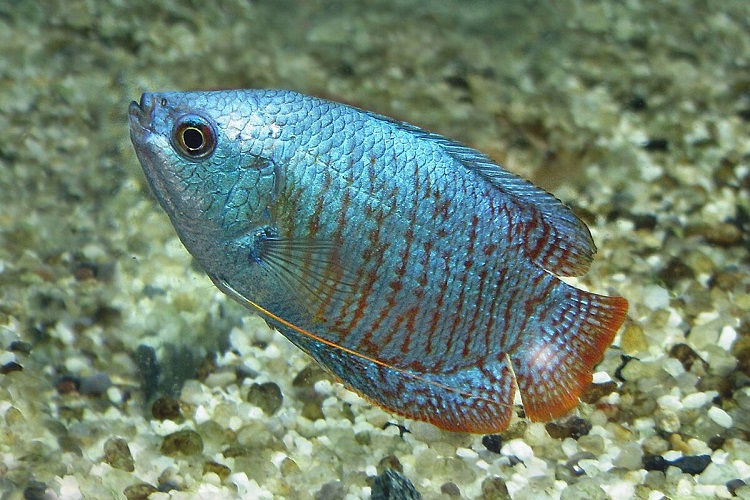
We’ve already looked at the lovely Honey Gourami, but there are other members of the Gourami family to consider. A labyrinth fish that needs access to the water surface to breathe, it’s a stunning species that is very peaceful and playful by nature.
You’ll find them in a wide range of colors, including some neon and near-luminous breeds, and a well-kept Dwarf Gourami pair make an excellent addition to the top and mid-levels of a community fish tank. Keep them at pH 6-7.5, and in water at 72-82°F.
At a Glance:
- Scientific Name: Trichogaster lalius
- Difficulty Level: Intermediate
- Adult Size: 3 inches
- Minimum Tank Size: 10 gallons
Guppy Fish

If you’re looking for a fantastic beginner community fish, the guppy may be right for you. They’re an immensely popular tropical aquarium fish, with a huge range of colors and iconic flowing fins that catch the eye.
They are excellent for beginners because they’re easygoing and don’t need a lot of complex care. They’re also quite adaptable, and will happily call all levels of your tank home, as they’re comfortable in a temperature range of 72-82°F and a water pH over 7.
Combined with their peaceful nature, this adaptability makes them a great choice to share space with others. If you have males and females in the same tank, you’ll soon find yourself watching happy families with plenty of little fry, as they’re a live-bearing species.
At a Glance:
- Scientific Name: Poecilia reticulata
- Difficulty Level: Easy
- Adult Size: 2 inches
- Minimum Tank Size: 5 gallons
Neon Tetra

With their enticing neon stripes and bright colors, it’s no wonder that Neon Tetra is one of the most popular fish for shared tanks. If you want a low-maintenance fish that adds fantastic visual value, you need these stunning community fish in your tank, period.
They do best in a school, flitting around the mid-levels of your tank, and will bring hours of gratification to your tank watching. They have a wide pH range (4-7.5) and do best at 70-77°F.
At a Glance:
- Scientific Name: Paracheirodon innesi
- Difficulty Level: Easy
- Adult Size: 1-1.5 inches
- Minimum Tank Size: 10 gallons
Celestial Pearl Danio

With an evocative name like Celestial Pearl Danio, you know this is a special little fish. This fish is also sometimes called the Galaxy Rasbora, and their tiny size makes them a great addition to planted nano tanks needing the community touch.
While the males will occasionally get a bit feisty and spar or display at each other, they’re generally peaceful and play nicely with fish of similar sizes. For happy fish, keep them at a pH of 6.5-7.5, and water temperature 73-79°F, and watch them play through all levels of the tank.
At a Glance:
- Scientific Name: Celestichthys margaritatus
- Difficulty Level: Intermediate
- Adult Size: 0.75 inches
- Minimum Tank Size: 10 gallons
Congo Tetra

Tetra species is a popular community fish for good reason. They’re easy to care for and bring a wonderful splash of color to the top and mid-level of your tank.
The Congo Tetra is an African native and can appear near-translucent to the eye. While they play well with others, they can be a little withdrawn if you have a lot of active or big fish in the tank. Keep them in water with a pH of 6-7.5, and a temperature of 75-81°F.
At a Glance:
- Scientific Name: Phenacogrammus interruptus
- Difficulty Level: Intermediate
- Adult Size: 3-3.5 inches
- Minimum Tank Size: 20 gallons
Platy Fish
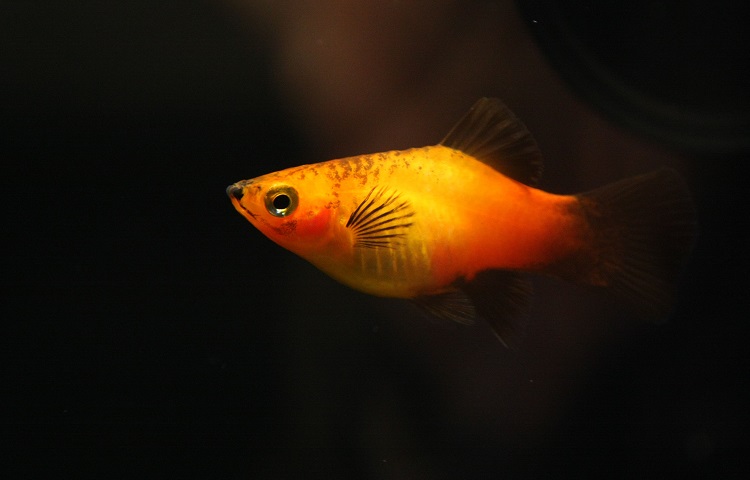
Often affectionately called “platies,” this is another peaceful live-bearing species, so expect some small fry if you have mixed males and females in your tank. There are multiple gorgeous platy breeds, and they’re perfect if you want small fish for your community tank setup.
Platies are great to add interest to the top water of your tank, but will also venture into the mid-water area. They’re also fantastic for algae control. They prefer a pH range of 6.8-8.5 and temperatures between 70-77°F.
At a Glance:
- Scientific Name: Xiphophorus spp.
- Difficulty Level: Easy
- Adult Size: 2-3 inches
- Minimum Tank Size: 10 gallons
Otocinclus

What’s a tank without a sucker fish? Otocinclus or “Otos” are a fantastic addition to any tank. They help keep your tank clean and fresh by feeding on algae, and watching them suck onto the bottom or side of the tank can be pretty entertaining.
However, this does mean you need to have a tank setup that will produce algae to keep them fed. While generally bottom dwellers, Otos kept in a small school of around six will also swim at the mid-level of the water. They prefer a pH of 6-7.5, and temperatures of 74-79°F.
At a Glance:
- Scientific Name: Otocinclus spp.
- Difficulty Level: Easy
- Adult Size: 2 inches
- Minimum Tank Size: 10 gallons
Cory Catfish

“Cory” is a catch-all name for about 160 different species of South American catfish. They tend to stay near the bottom of the tank, though you’ll see them dart to the surface for air occasionally.
Not only are they very peaceful fish despite their omnivorous diet, but they also do better in groups of six or more. With pals to frolic with, you’ll see them play comfortably with each other and other tank species. They prefer a pH of 5.5-7.8 (species dependant), and a water temperature of 72-82°F.
At a Glance:
- Scientific Name: Corydoras spp.
- Difficulty Level: Easy
- Adult Size: 1-4 inches
- Minimum Tank Size: 10-30 gallons (depending on species)
Molly Fish

If you’re planning a tank setup with hard water, Molly Fish are an excellent choice for your tank. While they’re not as easy as some on our list for beginners to care for, most Molly species are easy fish to keep, preferring water temperatures in the 72-78°F range and a pH of 7.5-8.5.
They’re live-bearing fish who will breed easily, and have a dazzling variety of fin shapes and colors to spice up your aquarium. You’ll find your Mollys at play in the midwater and top levels of the tank, happily coexisting with your other community fish.
At a Glance:
- Scientific Name: Poecilia sphenops
- Difficulty Level: Intermediate
- Adult Size: 3-5 inches
- Minimum Tank Size: 30 gallons
Black Skirt Tetra

Another popular Tetra fish, Black Skirt Tetra fish are more subdued than the bold and bright Tetras you may be used to, but they bring a lot of visual interest to the table. Boldly marked in black, they have unusual body and fin shapes that stand out from the crowd.
They need a small school of at least six fish to be happy, but once they’re in formation you’ll find them playing in the top and middle tiers of your tank. Keep them in temperatures of 70-82°F, with a pH of 6-7.5.
At a Glance:
- Scientific Name: Gymnocorymbus ternetzi
- Difficulty Level: Easy
- Adult Size: 2-3 inches
- Minimum Tank Size: 15 gallons
Bala Shark

It may surprise you to see a shark species on our list! While the Bala Shark looks like a smaller version of a marine shark, they’re nowhere near as vicious, and in fact can make very peaceful community fish.
Small tank mates may get mistaken for food, however, so they need to be among similar-sized species, meaning a nice big tank is a must. You’ll also need to make sure your shark has plenty of hiding spots, or it will get stressed under the constant attention. Bala Sharks prefer 72–82°F water and a pH of 6-8.
At a Glance:
- Scientific Name: Balantiocheilos melanopterus
- Adult Size: 12 inches
- Difficulty: Intermediate
- Minimum Tank Size: 120 to 150 gallons
Sparkling Gourami
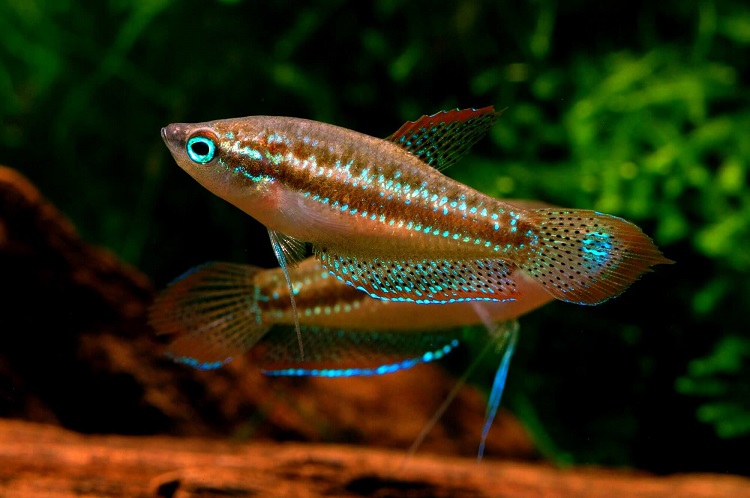
This little fish is a joy in any community fish collection. The Sparkling Gourami is slender, with jazzy dots and stripes over the whole body that lend it its sparkling appeal. Its fins are semi-transparent with a blue tinge, and have red edging and black spots.
Playful and active, these fish are easy to care for as long as they have plenty of plants in their tank. They’re quite small, however, and large tank mates can be a little too intimidating or even dangerous for them. To keep them happy, they need temperatures of 77-82.5°F, and a pH of 6-7.
At a Glance:
- Scientific Name: Trichopsis pumila
- Adult Size: 1.5 inches
- Difficulty Level: Easy
- Minimum Tank Size: 15 gallons
Glass Catfish

If you’re looking for visual interest in your tank, look no further than the Glass Catfish. These fish have almost fully translucent skin, allowing you to see their bones, and watching them swimming calmly around your tank is ethereal in a way it’s hard to beat.
Unlike most catfish, they tend to stay around the mid and top levels of your tank. They also need a school to be happy, so plan for at least five of them. Glass catfish require temperatures of 75-80°F, and can live in a pH range of 6.5-7.
At a Glance:
- Scientific Name: Kryptopterus vitreolus
- Difficulty Level: Intermediate
- Adult Size: 4-6 inches
- Minimum Tank Size: 30 gallons
Cherry Barb

Very active and brightly colored, this gorgeous little barb variety is sure to steal your heart. Cherry Barbs will dart around all levels of your tank, lending it a warm red-orange glow.
Plus, they play nicely with others, too. This isn’t just a community fish, but a very social species that will need a school to be truly happy, so you’ll need no fewer than six fish. They do best at a pH of 6-7, and temperatures of 73-80°F.
At a Glance:
- Scientific Name: Puntius titteya
- Difficulty Level: Easy
- Adult Size: 1.75- 2 inches
- Minimum Tank Size: 25 gallons
Kuhli Loach

The Kuhli Loach is always a stand-out in a freshwater tank. Unusually long and tubular, this eel-like fish also boasts an eye-catching stripe pattern that adds a touch of the extraordinary. They don’t school, so you don’t need to have a lot of them, and they’re self-contained fish that will happily mind their own business at the bottom of the tank.
Plus, they’ll help keep the tank clean as an added bonus. However, you will have to make sure your tank filter is covered with a strong mesh, as they do sometimes try to wriggle inside and get stuck. Keep them in a tank with a pH of 5.5-6.5 and a temperature of 75-86°F.
At a Glance:
- Scientific Name: Pangio kuhlii
- Adult Size: 3-4 inches
- Difficulty Level: Intermediate
- Minimum Tank Size: 15 gallons
Threadfin Rainbowfish
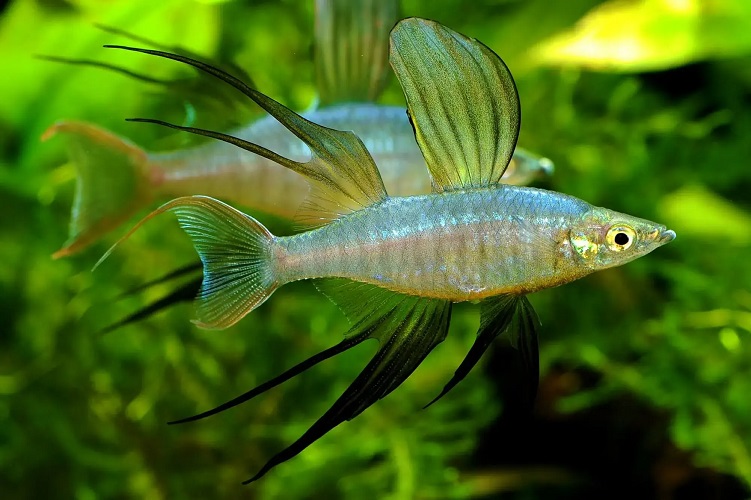
Another striking addition to a community fish tank, the Threadfin Rainbowfish is a glistening yellow-gold color, with semi-transparent fins and a unique fork-shaped tail. These fish boast round and flowing dorsal fins that follow the color shift along their bodies, as well as long flowing tails.
In contrast, the rest of their fins are ray-like and black. Threadfin Rainbowfish won’t suit a tank with fin-nippers, because the temptation will be too high, but they won’t be the trouble starters in any tank. They prefer water with a pH of 6-7 and a temperature of 73–84°F.
At a Glance:
- Scientific Name: Iriatherina werneri
- Difficulty Level: Easy to Intermediate
- Adult Size: 1.5-2 inches
- Minimum Tank Size: 20 gallons
What are Community Fish?
The concept behind community fish is very simple. Like the 24 community fish species mentioned above, they get along well with others! Community fish are not generally aggressive, aren’t scared to emerge in a tank with other fish moving around, and don’t naturally prey on each other. In the aquarium community, they’re also referred to as “peaceful” fish.
Community fish tanks have a lot of different fish species swimming around, echoing conditions you’d find in the wild, thus making them look more “natural.” And with so many beautiful species in the same place, community tanks make an excellent focal point.
Compatible Community Fish
While all of the fish above are community fish, it doesn’t mean that absolutely every fish on our list can be paired with every other fish.
When you’re creating a community fish tank, you will start with a list of community fish that are peaceful and pair well with other species. From there, you will need to consider the compatibility of the particular species that most appeals to you. Some community fish will only put up with tank-mates of a certain size or activity level, or the issue could be as simple as two species’ favored conditions not matching. Let’s take a closer look!
Community Fish Compatibility Factors to Consider
There are many factors which will affect the compatibility of community fish, some of which are more crucial than others. Here are some of the most critical criteria you need to consider when putting together a community tank.
Tank and Fish Size
All fish deserve a tank spacious enough for them to thrive. You need to plan the tank to the comfort of the largest species you intend to house in it.
While the minimum size is low for many of the community fish species we’ve highlighted, those minimums are based on a specific number of fish of a single species, with additional space needed as you add more fish beyond that number. With that in mind, a 30-gallon tank is a great starter size, and a 15-gallon tank is about the safe minimum for a healthy and thriving environment once you start introducing multiple fish species.
Furthermore, if you like larger display fish, you will need to size up accordingly. And if you’re displaying fish that need a specific warm temperature range, you do need to make sure that the heater is correctly rated for the tank size and volume.
However, tank size is not the only size that matters. As a good rule of thumb, community tanks should pair similar-sized species together. That goes double if any of the species is omnivorous or carnivorous – any significantly smaller fish will look like breakfast, even if they’re both considered peaceful fish breeds!
You could also have issues like a cheeky fin nipper not pairing well with fish with particularly dramatic fins. Some fish also get shy around very active shoals of other species and will hide if there’s a lot of activity even though there’s no real threat.
Bear in mind that many community fish need fish like them around them to feel happy. We’ve included some loners who will do well alone or in a pair on our list, but many need a larger population group – typically around five or six fish at a minimum. Plan your tank size and composition accordingly, or you’ll get overcrowded fast.
Tank Conditions
The ideal tank conditions for every species is the other key consideration for a community tank. There’s the saltwater vs. freshwater consideration of course, but you also need species that like the same pH levels, water temperature, and water hardness.
For most tropical species, a soft, slightly acidic water will do, but you should always check each individual species’ requirements. Remember that systems can be “buffered” with natural additions like driftwood as well.
Preferred Swim Levels
Different fish species gravitate to different areas of the tank – bottom, top, or middle. Choosing a good distribution across the levels helps avoid overcrowding while also making for a more visually pleasing and bustling tank.
Remember, a tank may technically be big enough for everyone to enjoy, but if all of your fish prefer the same level, you’ll have a bunch of unhappy fish and a tank with a single crowded layer with empty space above or below.
Environment
While you can successfully mix fish from different areas of the globe, it’s always good to build an environment that feels natural to your fish. Opt for community fish that have very similar natural habitats, or which live together naturally in the wild.
Decorations, hardscape, and substrate can give low-swimming fish places to hide and play. Many fish need to be able to retreat somewhere to unwind, especially if the tank is in a busy room. For some species, you also need to consider typical light levels and match them accordingly.
Light levels will also affect the planting in a tank. Most fish feel safer in a planted tank, as it mimics a natural environment and gives them a sense of safety. Regardless of their preferred light levels, most species also need a simulation of natural daylight times – usually about 8 hours a day. Keep this consistent and predictable.
How to Look After Community Fish?
Once you’ve built a beautiful tank and found the perfect community fish, you’ll need to perform regular maintenance to keep your fish healthy and your tank beautiful.
At the very least, you need an aquarium test kit to stay on top of water quality and know when maintenance is needed. You should also do a partial water change at least bi-weekly to keep the nitrate byproducts released into the water by decaying plants and fish waste at bay. Remember that the new water must be conditioned and at the same temperature as the tank! The water change is also a good time to remove algae from the glass and clean up the substrate.
Different fish need different diets, and you should match your feeding regime to the species you’ve chosen. Many community fish do well on flake food, though there’s frozen food to consider as well. If you have bottom-loving species, you need a sinking pellet or feed tablet to ensure feed gets through to them as well. You should also consider non-processed “treats” like veggies, brine shrimp, or bloodworm larvae to bring out the best in your fish.
Another feeding concern is algae. If you’re adding an algae-eating species to the tank, the fish can’t be introduced into a brand new setup. You’ll have to make sure that there’s enough algae for them to feed on, though algae wafers, gel foods, and a few vegetables can act as supplements.
Overfeeding can lead to ammonia spikes in the water, so be sure to approach feed time with a balanced hand, and observe the fish to make sure there isn’t food going to waste.
If you’re interested in breeding fish, know that a community tank isn’t the best setup for it. Many species will see the fry of other species as a tasty snack. A specialized breeding tank may be better for you.
Conclusion
Setting up a thriving community tank is a big milestone for anyone who loves aquariums. It can seem a little intimidating trying to find the perfect setup and species match for a happy, thriving tank, but the reward is well worth the effort.
Start slow and do your research! Take your time building up a gorgeous tank of compatible community fish like those on our list and you’ll be enjoying the fruits of your labor for years to come!

Ian Sterling, founder of Fishlab.com, began his aquarium journey over 30 years ago, driven by a deep fascination for fish and their diverse personalities. His website, Fishlab.com, is dedicated to making fishkeeping accessible and enjoyable, offering beginner-friendly guidance, expert insights, and a community for aquarists to connect and share experiences.


